The state of Louisiana is home to a diverse array of water bodies. These include bayous, oceans, and lakes, offering some of the most picturesque aquatic landscapes you’ll ever see. And when the temperature rises, there’s no better way to beat the heat than by taking a refreshing dip in one of Louisiana’s beautiful lakes. This article will take you through the finest Louisiana lakes, perfect for swimming.
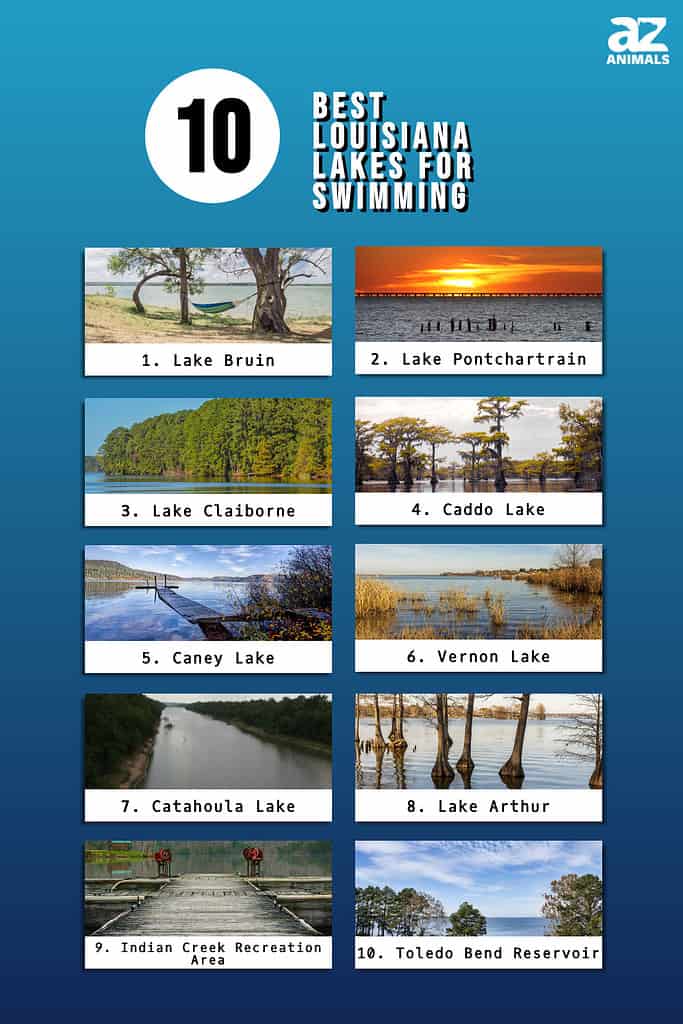
Discover the Top 10 Lakes in Louisiana for Swimming
1. Lake Bruin
Lake Bruin is a stunning lake nestled in the heart of east-central Louisiana. Covering an impressive 3,000 acres and stretching for 11 miles, this oxbow lake was formed when the Mississippi River eroded its banks and created a shortcut, leaving behind a water loop. The water is crystal clear and immaculately clean.
You’ll also see all kinds of creatures, from the majestic birds that soar overhead to the cute little turtles that sun themselves on the banks.
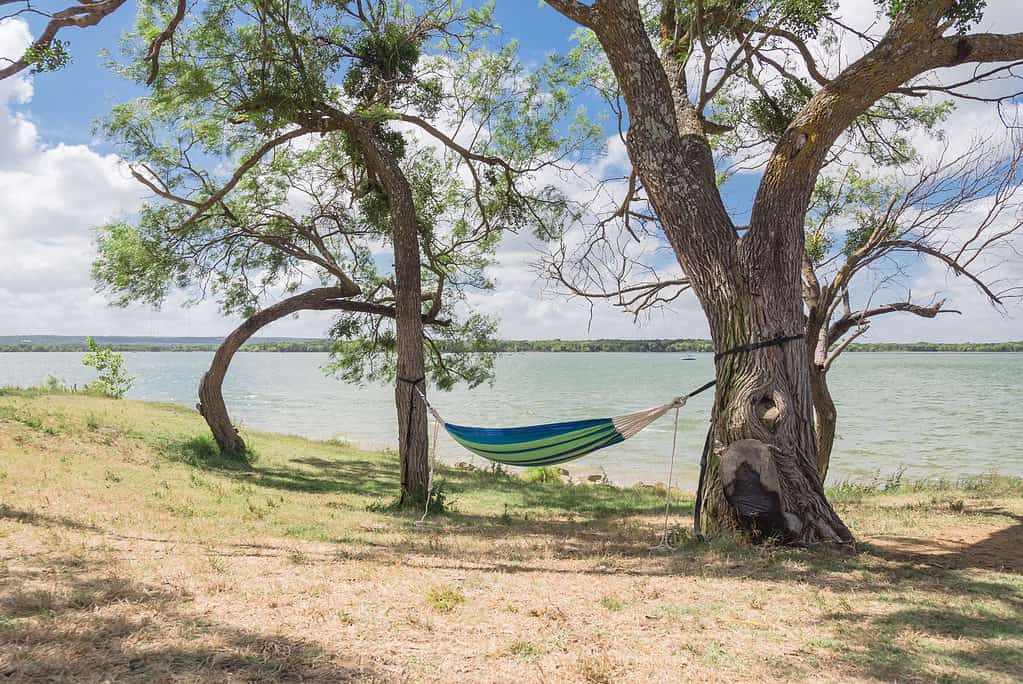
Enjoy the beauty and tranquility of Lake Bruin, located in southeastern Louisiana.
©Trong Nguyen/Shutterstock.com
2. Lake Pontchartrain
Lake Pontchartrain is a massive brackish lake that serves several parishes in Louisiana. It’s connected to the Gulf of Mexico by two passes: the Rigolets and Chef Menteur. This body of water is a hub for various activities like sailing, fishing, birdwatching, and swimming.
There are numerous public beaches situated right along the lake’s shore! Places like Fontainebleau State Park, North Shore Beach, and Bucktown Harbor Park are hot spots for lake-goers. You can also take in some breathtaking views of the lake from the Causeway Bridge — the longest bridge over water in the world!
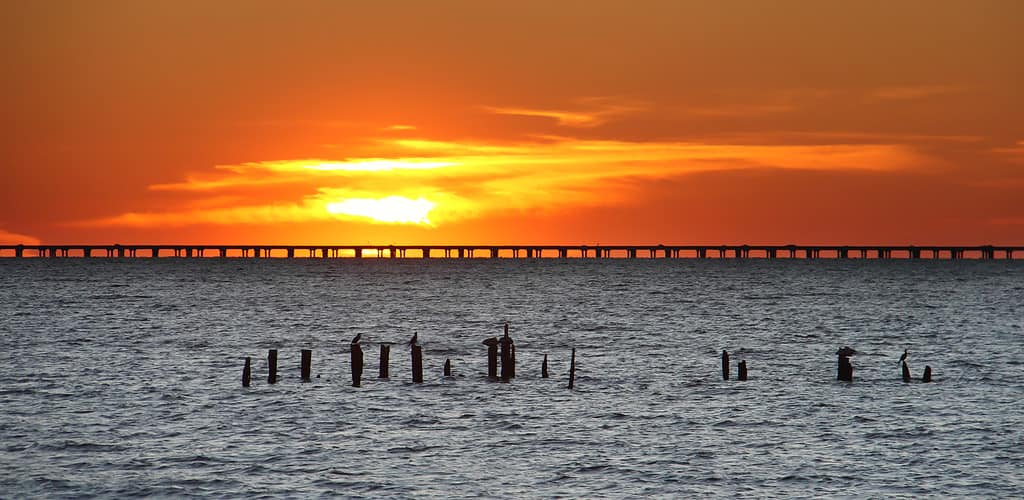
Lake Pontchartrain is known for its beauty, with many bridges spanning the lake.
©iStock.com/XKarDoc
3. Lake Claiborne
Lake Claiborne is a large body of water located near Homer, Louisiana. The lake’s colossal footprint spans roughly 6,400 acres. Its sparkling waters are crystal clear. The lake harbors various fascinating wildlife, including bald eagles, alligators, and deer.
Apart from swimming, you can also bask in the warm sun or hit the disc golf course for land-based entertainment. For your accommodation needs, the park offers cabins and lodges for rent. You can also bring along your RV or tent.
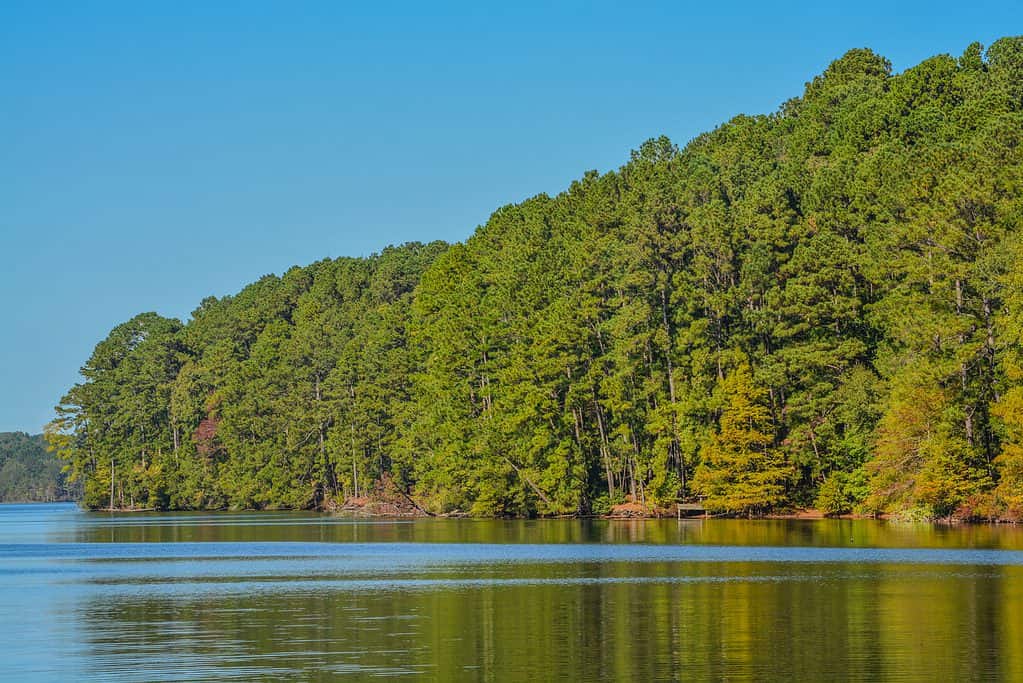
Lake Claiborne is surrounded by beautiful nature and is perfect for activities including swimming and fishing.
©Norm Lane/Shutterstock.com
4. Caddo Lake
Caddo Lake straddles the border of Louisiana and Texas. It boasts a whopping 25,400 acres, making it one of the largest natural freshwater lakes in the southern region. The lake is renowned for its ethereal beauty, with its cypress trees donning delicate strands of Spanish moss. Alligators, turtles, frogs, birds, and fish are just some species that thrive in the lake’s rich biodiversity.
You can experience the magic of Caddo Lake firsthand by taking a dip in its refreshing waters at Earl G. Williamson Park or Caddo Lake State Park (located on the Texas side). If you prefer to stay dry, you can explore the lake’s depths by boat or rent a paddleboat to take in the stunning scenery.
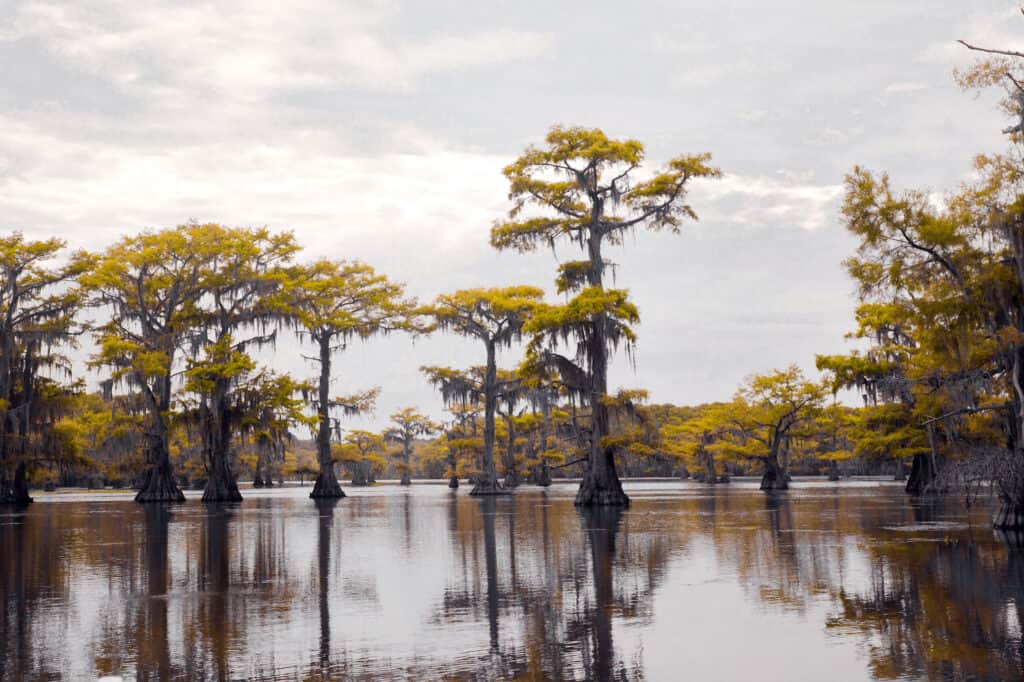
Caddo Lake is home to hundreds of species of fish including largemouth bass and
catfish
.
©MeganTea/Shutterstock.com
5. Caney Lake
Caney Lake, a sprawling 5,000-acre reservoir located in the northern region of Louisiana, was formed by damming Caney Creek. Visitors can indulge in a myriad of recreational activities at the Jimmie Davis State Park, including but not limited to swimming at the pristine beachfront of Caney Lake, launching their boats, angling from the numerous fishing piers, or relaxing at the serene picnic spots. Furthermore, outdoor enthusiasts can engage in invigorating hikes or bike rides along the picturesque trails that meander through the pine and hardwood forest surrounding the lake.
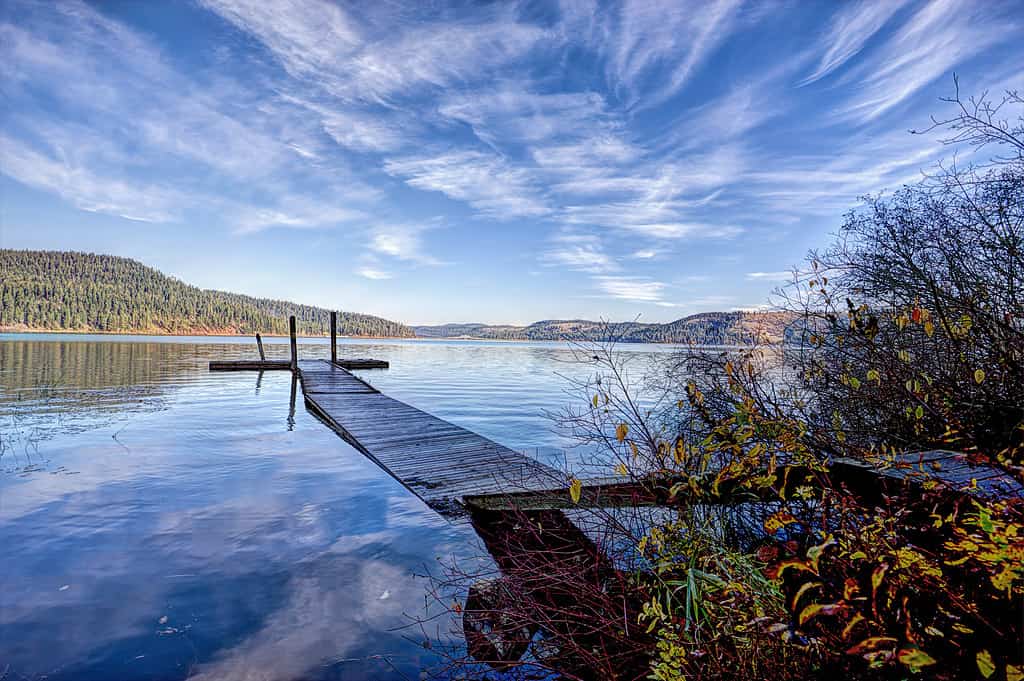
Caney Lake is a reservoir created by the damming of the Little River and offers some of the best fishing.
©Gregory Johnston/Shutterstock.com
6. Vernon Lake
Vernon Lake, situated in Vernon Parish, Louisiana, is a remarkable feat of human engineering. Constructed in 1963 by impounding Anacoco Creek (Anacoco Bayou), this 4,200-acre reservoir serves dual water supply and recreation purposes.
Hickory Ridge Recreational Park, situated on the lake’s shores, is a public facility overseen by the Vernon Parish Police Jury. The park boasts multiple fishing and swimming locations, making it a prime destination for outdoor enthusiasts.
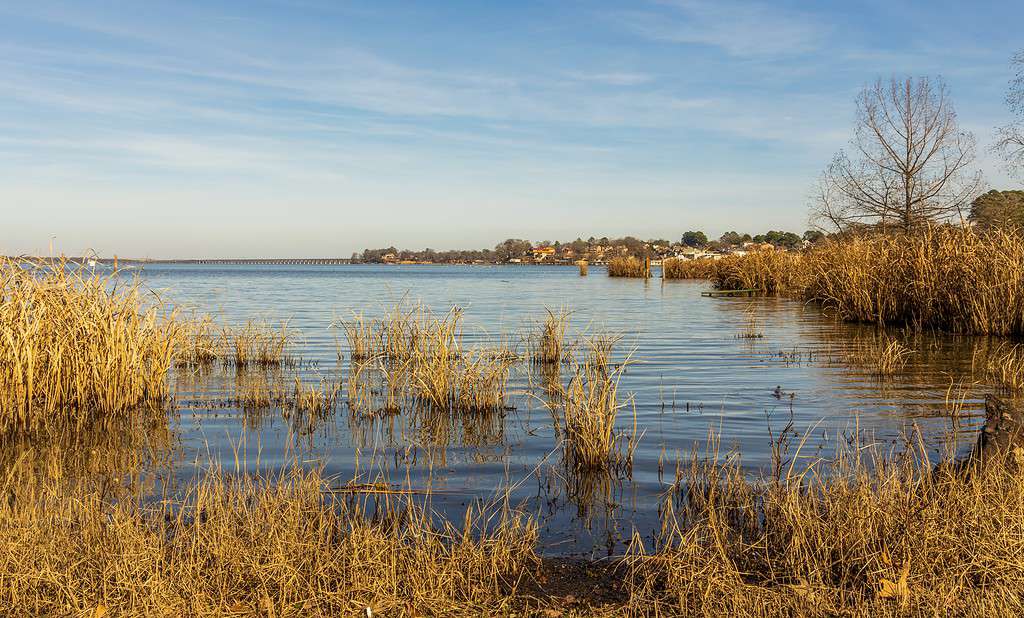
Located in Jackson Parish, Louisiana, Caney Lake provides recreational activities such as boating, swimming, camping, and fishing.
©Faina Gurevich/Shutterstock.com
7. Catahoula Lake
Catahoula Lake is a huge shallow lake at the heart of Louisiana that covers around 46 square miles. It’s a major part of the Catahoula National Wildlife Refuge, which safeguards approximately 25,000 sections of woodlands and wetlands. Catahoula Lake is a fundamental territory for transient birds, particularly waterfowl. You can swim in Catahoula Lake at Catahoula Recreation Area or Dewey Wills Wildlife Management Area. Hunting or fishing is also allowed in designated areas with a permit.
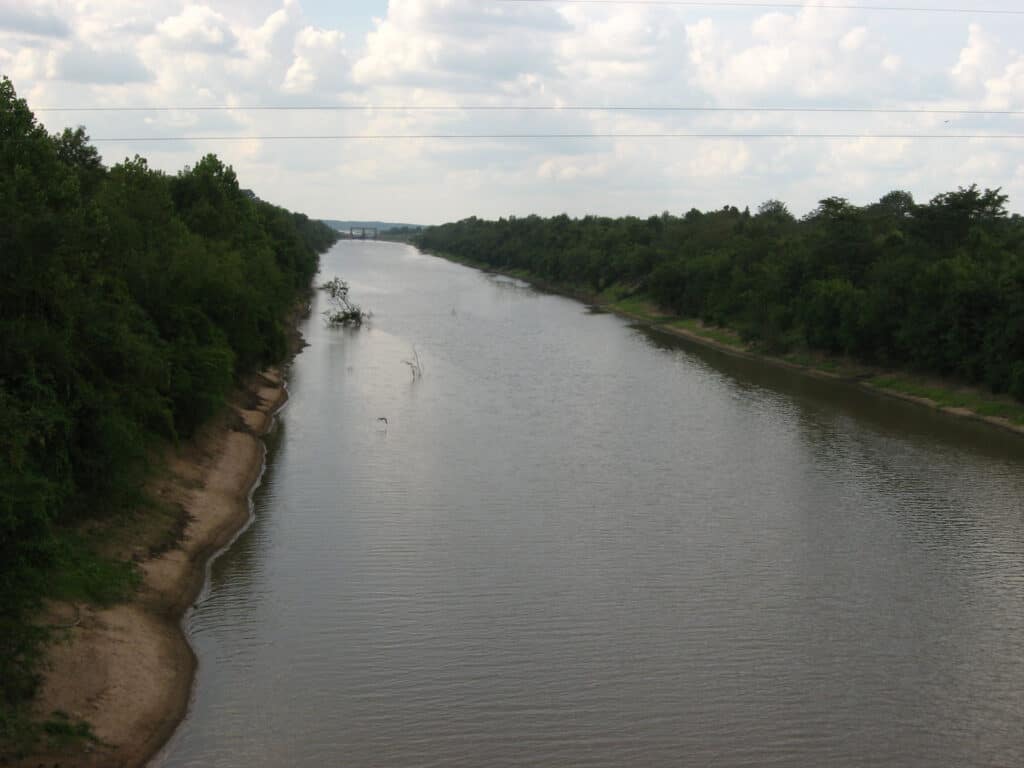
Catahoula Lake, the second-largest natural lake in Louisiana, was formed by a meteor impact over 70 million years ago
©Ken Lund / flickr – License
8. Lake Arthur
In Jefferson Davis Parish, there’s a lake called Lake Arthur. It is located in a town with a rich history, also named Lake Arthur. The northern shore of the lake is home to Lake Arthur Park. This park spans 11 acres and features a beautiful beach area for visitors to swim and sunbathe.
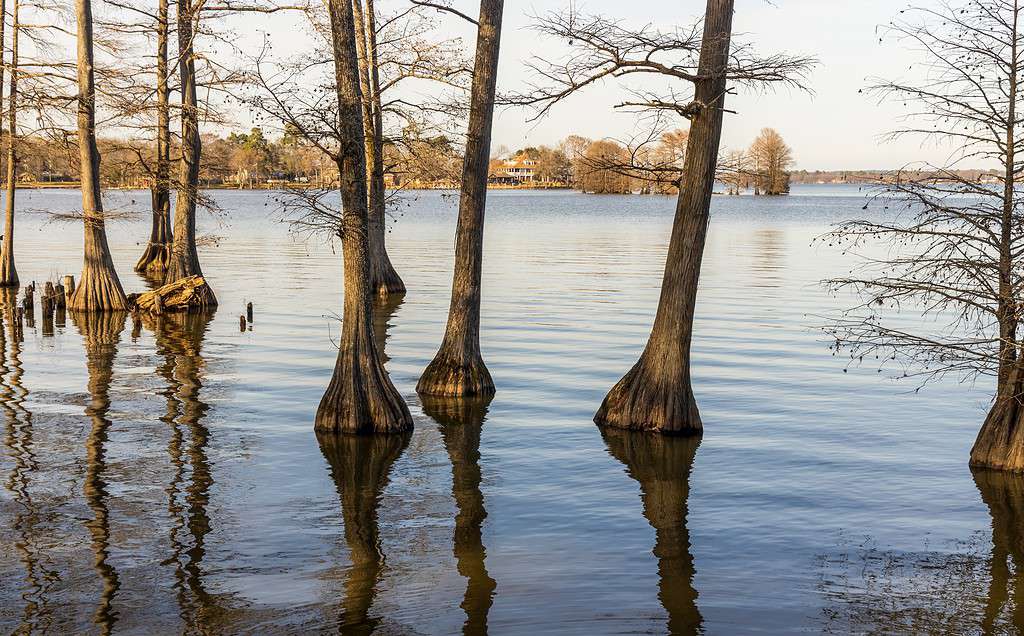
Enjoy the beautiful sights of Lake Arthur in Louisiana. It’s also a popular spot for boating and fishing.
©Faina Gurevich/Shutterstock.com
9. Indian Creek Recreation Area
The Indian Creek Recreation Area sprawls across Central Rapides Parish in Louisiana. It offers a 100-acre developed recreation zone, 250 acres of primitive camping, and a massive 2,250-acre Indian Creek Lake. More than 100 campsites, with water and electricity, exist within the recreation area. There are laundry facilities, three beach areas for swimming, a playground, a boat launch, and a pavilion.
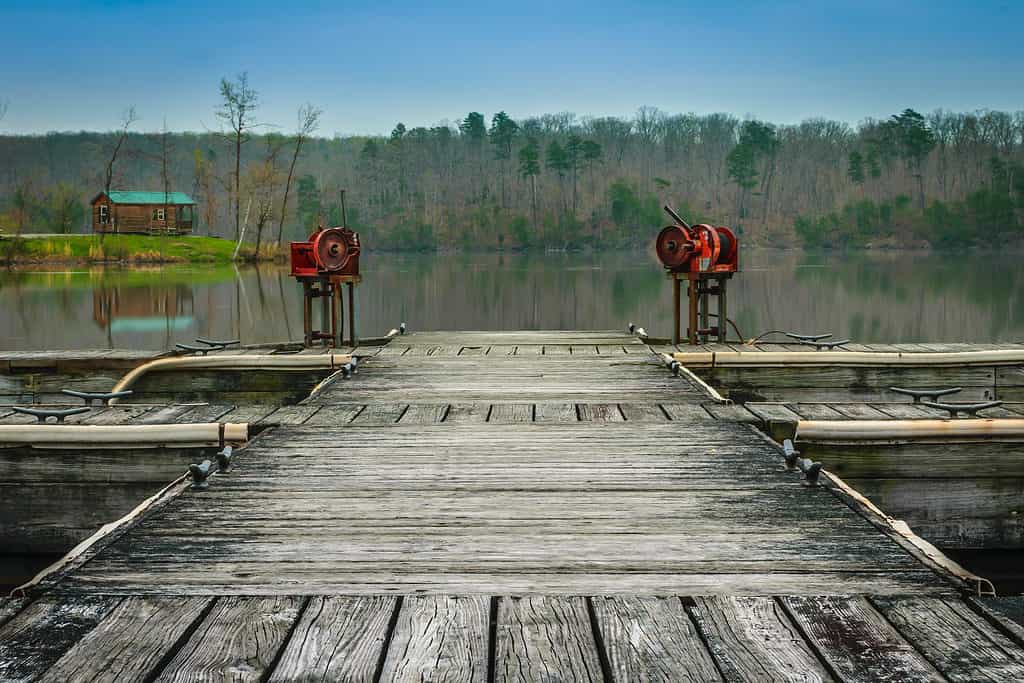
Indian Creek Recreation offers opportunities for fishing, bird watching, and nature walks.
©Thomas Kelley/Shutterstock.com
10. Toledo Bend Reservoir
Toledo Bend Reservoir is the biggest artificial lake in the south and the best for bass fishing. It spans 185,000 acres, 65 miles along the Sabine River. It offers boating, water skiing, swimming, tubing, and jet skiing.
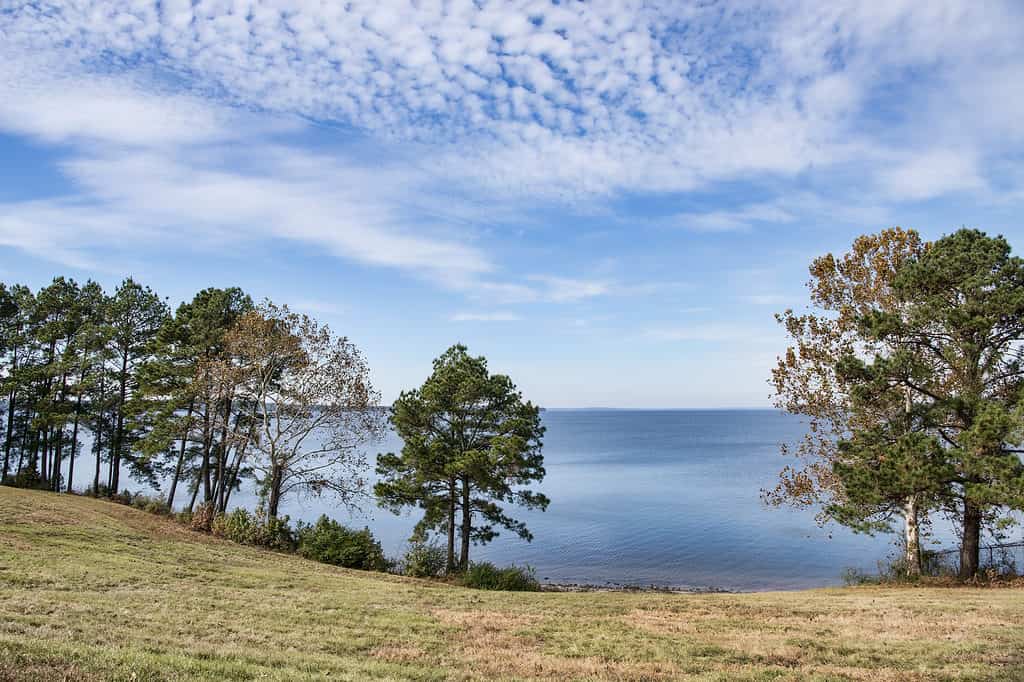
Toledo Bend Reservoir is one of the largest reservoirs in the U.S., spanning across Texas and Louisiana.
©Bonnie Taylor Barry/Shutterstock.com
Why Are Some Lakes Not Suitable for Swimming in Louisiana?
There are many reasons why some lakes in Louisiana are unsuitable for swimming, and some may surprise you. Here are some of them:
1. Chemical Contamination
Chemical contamination is a primary factor contributing to the unsuitability of several lakes in Louisiana for swimming. Such contamination can stem from various sources, including industrial spills, agricultural runoff, wastewater discharge, or natural occurrences like mercury deposits. This pollution significantly impacts water quality and poses potential health hazards to humans and wildlife. Mercury can accumulate in fish and trigger neurological impairment when ingested in large quantities.
2. Harmful Algal Blooms
The emergence of harmful algal blooms (HABs) has rendered some lakes in Louisiana unsuitable for recreational swimming. These occurrences entail surges of algae that secrete toxins or diminish oxygen levels in the water, causing fatalities among fish, repulsive odors, and various health-related issues for animals and humans. Nutrient pollution, elevated temperatures, etc., typically cause HABs. Symptoms of HAB exposure may encompass skin irritation, ocular discomfort, respiratory distress, nausea, emesis, diarrhea, and hepatic damage. Notably, various lakes in Louisiana, including Lake Pontchartrain and LSU University Lakes, have encountered HABs.
3. Alligators
Alligators are indigenous to Louisiana; they’re in virtually every freshwater environment. With the potential to attain lengths of up to 15 feet and weights of up to 1,000 pounds, alligators are opportunistic predators that prey on fish, turtles, birds, mammals, and humans on rare occasions. Although rare, alligator attacks typically result in death. At least 2 million alligators are found in Louisiana, and incidents of swimmers being attacked in lakes are common.
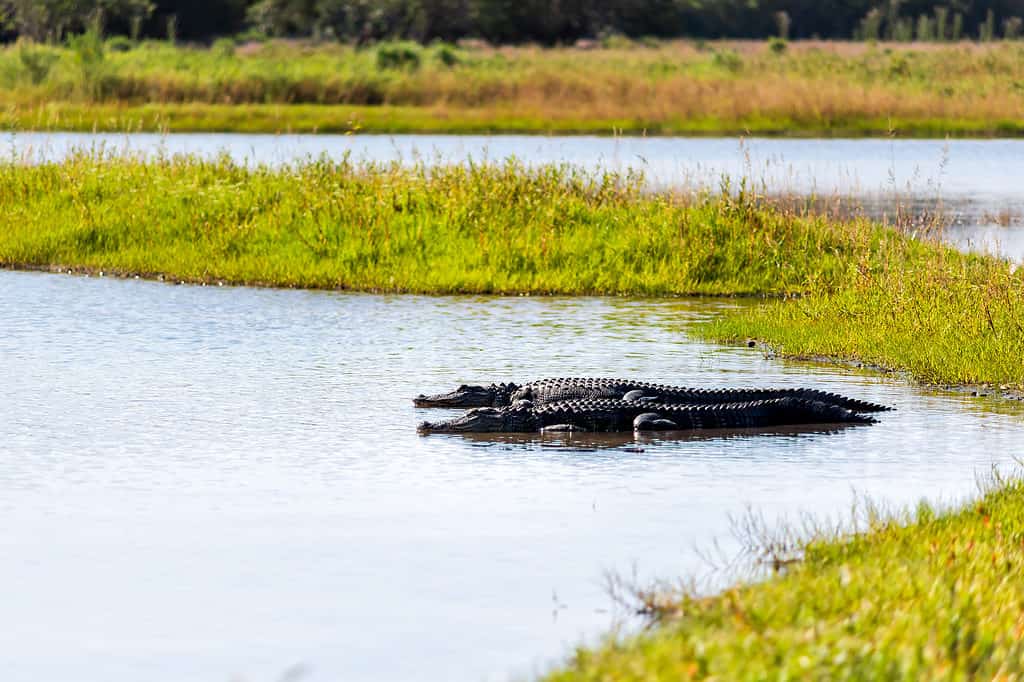
Alligators inhabit many of the waterways in Louisiana, and swimming or fishing can be dangerous.
©Kristi Blokhin/Shutterstock.com
4. Snakes
Louisiana harbors 47 types of snakes, among them seven venomous ones: pygmy rattlesnake, Texas coral snake, timber rattlesnake, eastern diamondback rattlesnake, cottonmouth (otherwise known as water moccasin), copperhead, and the eastern coral snake. These reptiles occupy different territories close to water sources, like bogs, swamps, timberlands, fields, and trenches.
Their instinctual protection mechanisms might incite them to nibble when they see danger or incitement. Side effects of venomous snake bites might incorporate, but not restricted to, uneasiness, swelling, vomiting, bleeding, redness, sickness, discombobulation, and respiratory trouble. Swift and appropriate treatment is imperative to avoid fatalities.
5. Leeches
Leeches are parasitic worms that can attach to their hosts’ skin or mucous membranes and feed on their vital fluids. Typically found in stagnant or slow-moving waters with plentiful vegetation or organic matter, these creatures threaten human health by inducing sensations of itching, burning, inflammation, infection, and allergic reactions. Furthermore, leeches can transmit an array of diseases to their hosts, including but not limited to bacterial infections and anemia.
6. Brain-Eating Amoeba
Certain lakes in Louisiana are infested by Naegleria fowleri, commonly known as brain-eating amoeba. This minuscule organism thrives in warm freshwater and soil. It can infiltrate the human body through the nasal cavity during aquatic activities in contaminated water. Once inside the body, it migrates to the brain and triggers an infrequent yet perilous infection called primary amebic meningoencephalitis (PAM), which induces a severe headache.
7. Water Depth
Certain lakes may not be ideal for swimming due to their respective depths. For instance, shallow lakes may conceal submerged hazards, such as rocks, stumps, or debris, which can potentially cause injury to swimmers. Conversely, deep lakes may feature strong currents, chilly temperatures, or reduced visibility, posing challenges or hazards for swimmers.
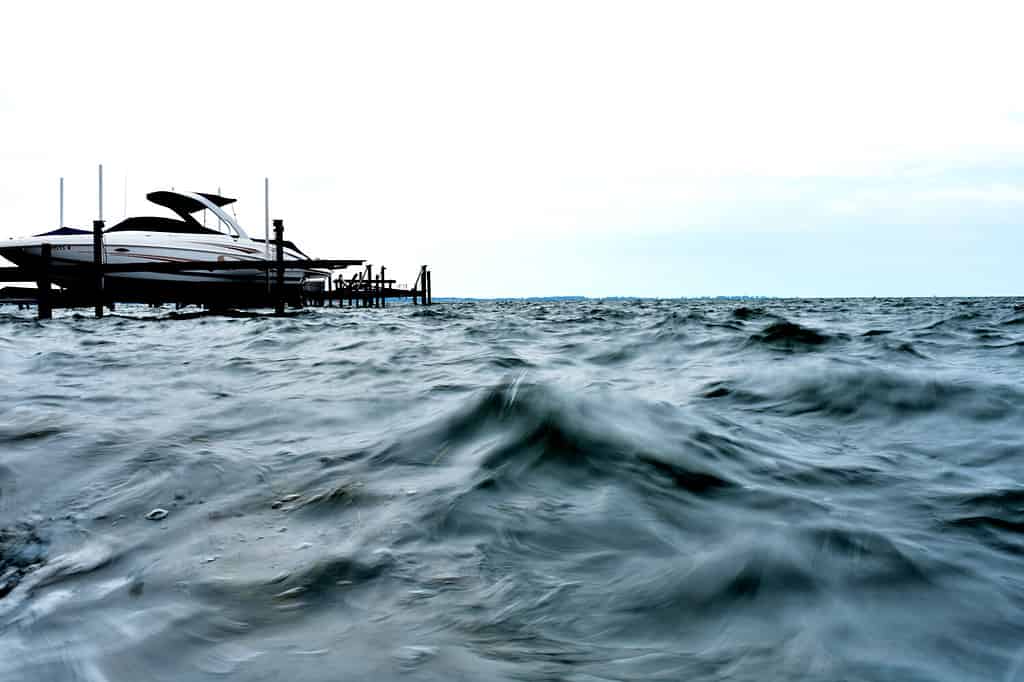
Some lakes can be too deep to safely swim in, due to strong water currents, steep drop-offs and other dangers.
©Paper and Lens Co/Shutterstock.com
8. Water Access
Certain bodies of water in Louisiana are either under private ownership or supervised by state and federal agencies that may impose specific protocols or restrictions on swimming activities. A prime instance of this is Lake Bistineau – a state park with two swimming pools. However, taking a plunge in the lake is prohibited per the governing regulations.
What Are the Safety Precautions to Take While Swimming in Louisiana Lakes?
Here’s a list of seven safety measures swimmers should adopt to avert any mishap while taking a dip in Louisiana’s lakes:
1. Check for Advisories
Before you visit the lake, we recommend that you ascertain the existence of any fish consumption or swimming advisories that might have been released by the Louisiana Department of Health (LDH) or the Louisiana Department of Environmental Quality (LDEQ).
These advisories serve to caution you against potential exposure to pollutants such as mercury or organic chemicals in select water bodies and furnish guidance on permissible levels of fish intake or frequency of swimming. The advisories are accessible on the LDH website or through the interactive map featured on the LDEQ website.
2. Avoid Swimming after Heavy Rains
When it starts pouring, all sorts of filth get dumped into waterways. Sewage overflows, stormwater runoff, agricultural runoff, and animal waste flush harmful pollutants, bacteria, and parasites straight into water bodies. These microorganisms can lead to infections and illnesses like diarrhea, nausea, vomiting, skin rashes, eye irritation, and ear infections. To mitigate the likelihood of exposure to these contaminants, we recommend abstaining from swimming in zones marked with cautionary advisories or after downpours.
3. Avoid Ingesting or Swallowing the Water
Although the water might appear crystal clear and pristine, it could still harbor dangerous bacteria and toxic substances that may inflict illness upon you. To avoid swallowing or taking in the water unintentionally, keep your mouth shut while swimming, refrain from submerging your head underwater, and steer clear of drinking from the lake. Should you feel dehydrated, bring your bottled water or use a filter or purifier to treat the lake water before quenching your thirst.
4. Avoid Swimming with an Open Cut or Wound
An open wound or cut can invite nasty bacteria and parasites to invade your body. And some of these infections can pack a punch, like the dreaded flesh-eating disease or a bacterial infection called vibriosis. To stay safe, steer clear of swimming with an open wound. However, slap on a waterproof bandage if you can’t resist taking a dip. Once out of the water, hop in the shower and give yourself a good scrub down. Remember to clean and disinfect that cut as soon as possible!
5. Protect Your Skin
Exposure to the sun’s UV rays can harm your skin and heighten the likelihood of developing skin cancer. To shield your skin from getting scorched or sunburnt, slather on a broad-spectrum sunscreen having a minimum SPF of 15 before taking a dip. Reapply it every two hours or when you sweat. Don a cap, sunglasses, and protective attire that cover your vulnerable skin. If possible, seek refuge under a shade and steer clear of swimming during peak sunny hours (from 10 a.m. to 4 p.m.).
6. Watch for Motorboats, Jet Skis, and Other Lake Users
While swimming in a lake, it’s possible to run into people maneuvering watercrafts such as motorboats, Jet Skis, kayaks, canoes, and paddle boards. These conveyances can be risky for swimmers if they’re not cautious. To avoid collisions and mishaps, be alert for motorboats, Jet Skis, and other lake-goers, and avoid crossing their paths. Please don’t presume they can detect your presence or hear your calls. Make yourself visible by donning a brightly-colored swimsuit or swim cap.
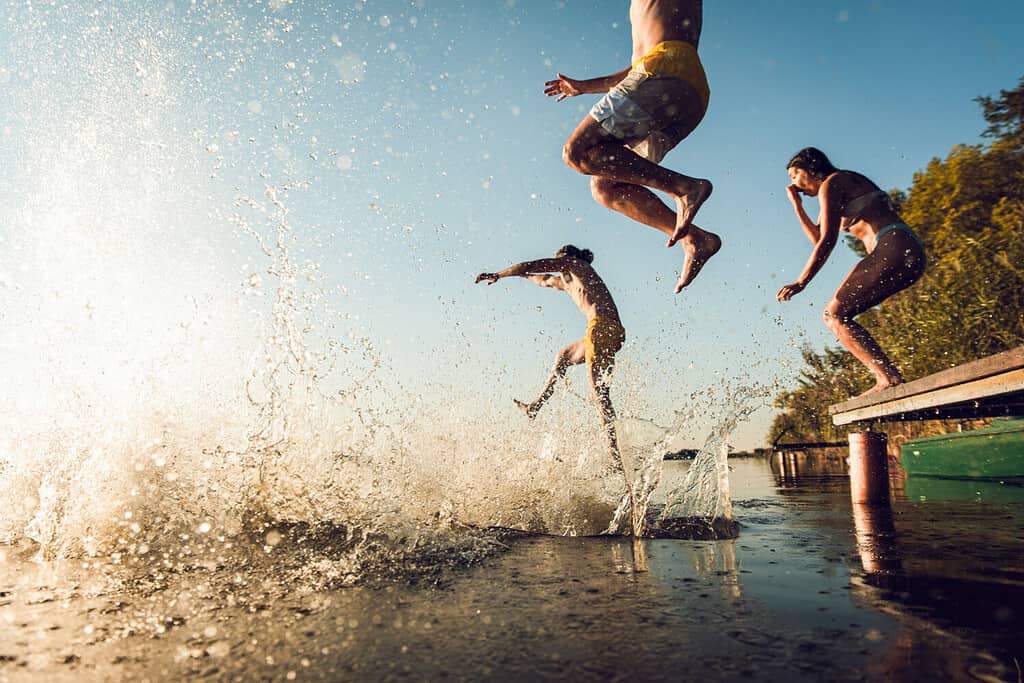
Stay safe while swimming by obeying posted signs and warnings, and avoiding areas with floating debris or murky water.
©Zoran Zeremski/Shutterstock.com
7. Always Have Adult Supervision
Taking a dip in a lake is a challenging feat compared to a controlled pool environment. The ripples, currents, depth, temperature, visibility, and wildlife all make it riskier for anyone who isn’t a seasoned swimmer.
So, if you’re planning to swim in a lake, ensure you’ve got an adult companion keeping an eye out for you, especially if you’re a kid or have any medical conditions. Never take the plunge all by yourself or push beyond your limits. Knowing how to swim and having a few water safety tricks up your sleeve, like floating, treading water, and signaling for assistance, is essential.
Enjoying Louisiana’s Lakes Safely and Joyfully
Louisiana has abundant lakes ideal for outdoor activities like swimming, boating, and fishing. These glistening water sources present a rejuvenating respite from the scorching heat and busy urban existence. Nevertheless, as with any body of water, it’s imperative to prioritize safety and comply with the guidelines and protocols established by each lake. This guarantees an enjoyable experience for all parties involved without any unforeseen misfortunes.
Summary of 10 Best Louisiana Lakes for Swimming
Here’s a recap of the top 10 lakes in Louisiana suitable for swimming that we took a look at.
| Number | Lake | Size |
|---|---|---|
| 1 | Lake Bruin | 3,000 acres |
| 2 | Lake Pontchartrain | 402,781 acres |
| 3 | Lake Claiborne | 6,400 acres |
| 4 | Caddo Lake | 25,400 acres |
| 5 | Caney Lake | 5,000 acres |
| 6 | Vernon Lake | 4,200 acres |
| 7 | Catahoula Lake | 30,000 acres |
| 8 | Lake Arthur | 11 acres |
| 9 | Indian Creek Recreation Area | 2,250 acres |
| 10 | Toledo Bend Reservoir | 185,000 acres |
The photo featured at the top of this post is © iStock.com/jacoblund
Thank you for reading! Have some feedback for us? Contact the AZ Animals editorial team.






